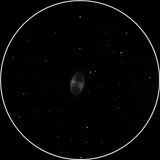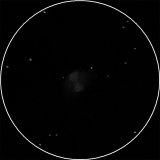
| MESSIER 27 |
|---|
RA: |
19h 59m 36s |
|
DEC: |
+22° 43' 00'' |
|
Type: |
Planetary nebula |
|
NGC: |
6853 |
|
Magnitude: |
7.50 |
|
Surface brightness : |
||
Apparent dimensions : |
8.0'x5.7' |
|
Distance: |
1,360 ly |
|
The Dumbbell Nebula (also known as Messier 27, M 27, or NGC 6853) is a planetary nebula (PN) in the Vulpecula constellation, at a distance of about 1360 light years. This PN appears to be shaped like an prolate spheroid and is viewed from our perspective along the plane of its equator. In 1992, Moreno-Corral et al. computed that the rate of expansion in the plane of the sky of this PN was no more than 2″.3 per century. From this, an upper limit to the age of 14,600 yr may be determined. This object was the first planetary nebula to be discovered; by Charles Messier in 1764. At its brightness of visual magnitude 7.5 and its diameter of about 8 arcminutes, it is easily visible in binoculars, and a great observing target in amateur telescopes. |
||
Other sketches |
|||||
 |
|||||
Messier 27 (July 07). |
|||||
VEDRAN VRHOVAC© 2006.-2007. |
